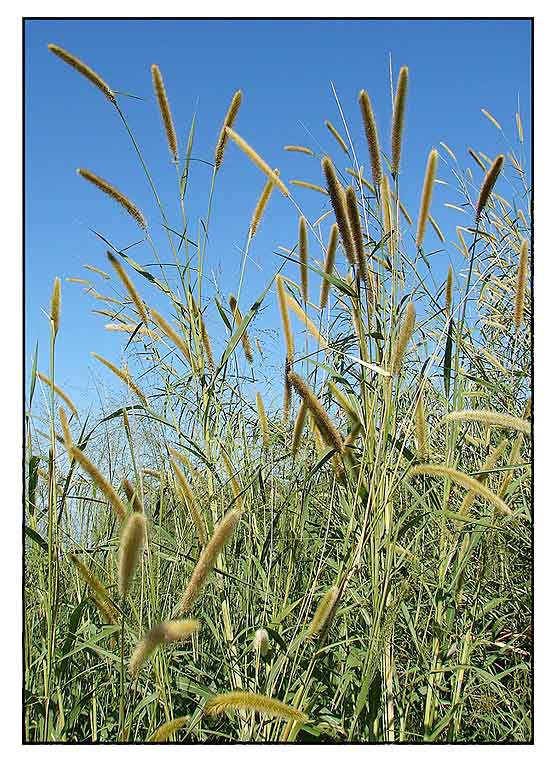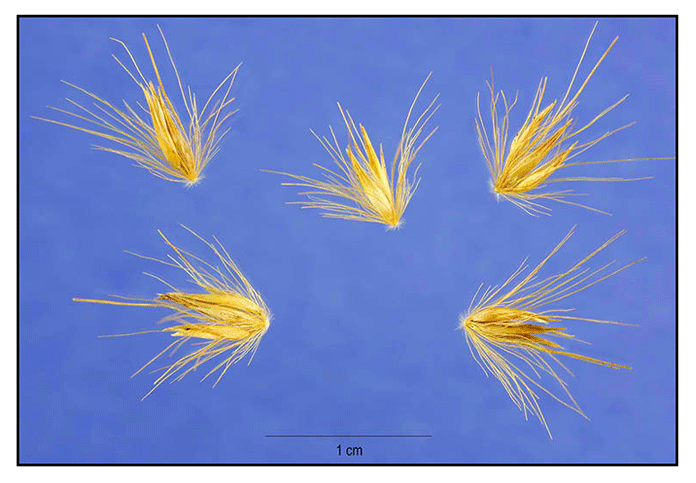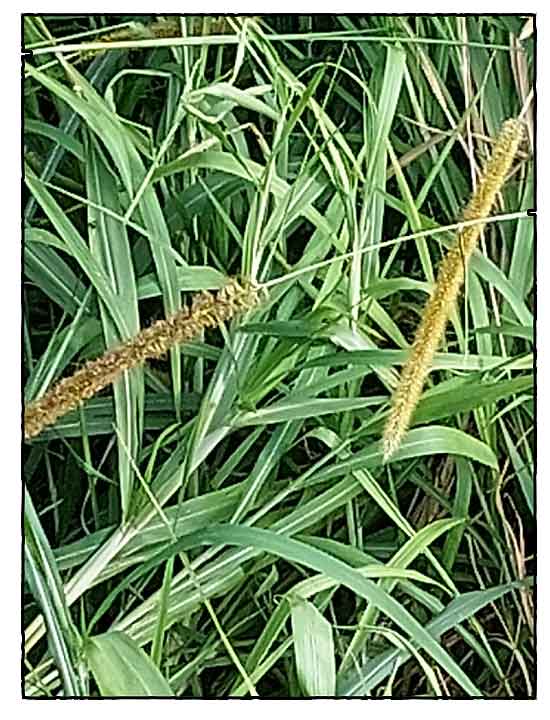 Gen info Gen info
• Cenchrus purpureus (Pennisetum purpureum), also known as Napier grass, elephant grass, or Uganda grass, is a species of perennial tropical grass native to the African grasslands.
• Primarily used for grazing, it has
recently been used as part of a push-pull agricultural pest management strategy. (19)
•
Push-pull management involves a desired crop plant alongside a "push plant" that repels pests, with the 'pull crop' around the perimeter of the plot, which draws insects out of the plot. (19)
- Napier grass plantations produce about 40 tonnes of dry biomass per hectare per year with average energy content of 18 Gj (5 MWh) per tonne, and can be harvested many times per year. (19)
- Napier grass is the most important fodder crop for dairy farmers in East Africa.
Botany
• Pennisetum purpureum is a tall, robust, deep-rooting, erect perennial, with short rhizomes, forming clumps up to 1 meter across. Stems are up to 7 meters tall and 3 centimeters in diameter, up to 20-noded. Leaf-sheath is glabrous to short bristly. Leaf blade is linear with broad base and acute tip, up to 120 centimeters by 5 centimeters, glabrous to hairy at the base, with a prominent midrib along the lower surface. Inflorescence is a dense spike-like panicle, up to 30 centimeters tall and 30 millimeters wide, not including the the 16 to 40 millimeters long bristles on the spikelets. Spikelets are 5 to 7 millimeters long, solitary or in clusters of up to five. (1)
 Distribution Distribution
- Introduced to the Philippines.
- Cultivated for forage.
- Native to Aldabra, Algeria, Angola, Benin, Burkina, Burundi, Cameroon, Central African Repu, Chad, Congo, Equatorial Guinea, Ethiopia, Gabon, Gambia, Ghana, Guinea, Gulf of Guinea Is., Ivory Coast, Kenya, Liberia, Malawi, Mali, Mozambique, Nigeria, Oman, Rwanda, Senegal, Seychelles, Sierra Leone, Sudan, Tanzania, Togo, Uganda, Zambia, Zaïre, Zimbabwe. (3)
Constituents
- Plant yields per 100 g of hay: 10.9 g water, 8.2 g protein, 1.8 g fat, 68.6 g total carbohydrate, 34.0 g. fiber, and 20.5 g ash. Silage yields 5.8 g protein, 4.9 g fat, 73.4 g total carbohydrate, and 15.9 g ash. Fresh grass yields 77.8 g water, 1.0 g protein, o.5 g fat, 17.6 g total carbohydrate, 3.1 g ash, 0.12% Ca and 0.07% P. Also a good source of carotene 182-221 mg/g, tocopherol 195-260 mg/g. (2)
- Proximate analysis of matrices of young shoots yielded moisture 89.00%, total ash 2.00% WW and 18.18% DW, crude protein 2.97% WW and 27.00% DW, crude fat 1.63% WW and 14.82% DW, total carbohydrate 3.40% WW and 30.91 DW, and total metabolizable energy value 34.48 kcal 100gG WW and 313.45 kcal 100gG DW. (see study below) (5)
- Analysis of young shoots yielded alkaloids, cyanogenic glycosides, flavonoids, oxalates, phytates, saponins, and tannins. Antinutrients composition yielded tannins (28.64%), cyanogenic glycosides (2.830%), oxalates (0.159%), phytates (0.006%) and saponins (0.850%) (see study below) (5)
- Yields 1.5% essential oil and 3.5% fixed oil. The oil is rich in phospholipids and sterols. (9)
- High performance liquid chromatography (HPLC) of aqueous extract of shoots revealed
3-O-rutinoside, ellagic acid, catechin, rutin, and kaempferol. (see study below) (21)
- Proximate analysis of matrices of matured shoots revealed: moisture 91%, total ash 22.20% DW, crude protein 20.11% DW, crude fat 14.00% DW, total carbohydrate 27.24% DW, and total metabolizable energy value of 315.4 kcal/100 g DW. Mineral content
analysis yielded: calcium 1.479 mg/100g, cadmium 0.001 mg/100g, copper 0.017 mg/100g, iron 0.20 mg/100g, manganese 0.043 mg/100g, potassium 10.715 mg/100g, sodium 0.495 mg/100g, and zinc 0.045 mg/100g. Phytochemical screening yielded alkaloids, flavonoids, glycosides, oils, saponins, steroids, tannins, terpenoids, with absence of acidic compounds and resins. (22)
Properties
- Studies have suggested antiulcer, antidiabetic, antibacterial, antimalarial properties.
Parts used
Leaf, stalk, stems, culms, sap.
 Uses Uses
Edibility
- Young leaves and shoots are edible; cooked to make soups and stews. (19)
Folkloric
- In Spanish Guinea, infusion of leaf and stalk used as diuretic in anuria or oliguria. In Central Africa, used as a source of medicinal salt. (2)
- In Africa, seeds used for general healing, eye and ear afflictions. Also used as diuretic, laxative and for parasitic infection and venereal diseases.
- In Ivory Coast-Upper Volta, root decoction used for blenorrhea. In the Congo, lightly salted sap expressed from young shoots heated over the fire is instilled in the eyes to treat cataracts; sap is also used for wound healing. In Gabon, stem sap is used for ear problems. In Nigeria, seed is used to cure headaches. (4)
- In Sierra Leone, used for asthma. (12)
Others
-
Forage: One of the highest yielding tropical forage grasses. In the Philippines, it is used to suppress Imperata cylindrica. (2) Leaves eaten by gorillas with ethnomedical laxative effect and benefits for mouth infections, gingivitis and thrush. (18) The grass is the most important fodder crop for dairy farmers in East Africa.
- Paper: Said to equal bamboo for paper making. (2) Culms are suitable source for good quality paper.
- Ritual: In Gabon, culms are laid across door thresholds to prevent entry of evil spirits. In Taganyika, sap is a constituent of plant formulations taken by mouth as a tranquilizer for someone possessed by spirits. (4)
- Small construction: Thick culms used in making fences, screens and mud reinforcements.
- Biomass: Grass has low water and nutrient requirements. It is an environmentally friendly and renewable source, with high biomass production at about 40 tons/hectare/year, and harvested 4 to 6 times per year. (11)
- Agroforestry: Napier grass is valuable to African landscapes as it prevents soil erosion. Besides improving soil fertility, it also serves as a fire break and wind break. (19)
- New commerce: A Dutch company has turned the grass into a biomaterial product that can be used for packaging. (19) Vibers™ produces a biomaterial product from elephant grass without using chemical processing. The technology has low ecological footprint, scalable, and sustainable. (20)
Toxicity
• Report of fatal nitrate poisonings in cattle fed solely on a diet of Napier grass. Levels of nitrate averaged 28.3 mg/g, with samples as high as 44 mg, where non-toxic areas showed 3.9 mg/g. (Seiler et al.) (2)
Studies
• Nutritional and Antinutritional Components: Study evaluated the matrices of young shoots of Pennisetum purpureum to proximate and phytochemical analysis. Results showed P. purpureum is relatively safe for consumption, and the nutritional quality may be improved through dehydration. (see constituents above) (5)
• Antibacterial: Study evaluated five Cameroonian medicinal plants ( A. cordifolia, E. speciosa, L. aestuans, Pennisetum purpureum and S. campanulata) against 15 gram-negative bacterial including MDR phenotypes. Against 15 tested bacteria, P. purpureum showed 66.7% antibacterial activity. (6)
• Bioenergy Potential: Study evaluated the productivity and bioenergy potentials of Napier grass. Results showed a biomass productivity of 7-11t/ha. The liquid extract showed pH 5.55-5.98, electrical conductivity 14,610-48,214 µS/cm, specific gravity 1.56-1.60, sugars 2.59-4.47%, and ethanol 1.35-2.85%. The gross calorific heating value of the bagasse ranged from 15.776 - 17.07 Mj/kg. Results suggest a potential for the liquid extracts as alternative feedstock for sugar and ethanol production, while the bagasse has the potential as fuel for power generation through conventional steam turbine cycle. (7)
• Anti-Gastric Ulcer Effect / Fresh Leaves: Study evaluated the anti-gastric ulcer effect of fresh leaf samples of achara Ibeku on ethanol induced gastric ulcer model using measures of gastric mucus secretion, mucus cells count and malondialdehyde concentration. Results showed amelioration of gastric ulcer effects. (10)
• Cellulose from Elephant Grass As Alternative of Bioplastic Material:
Study reports on making bioplastic from mixing cellulose pulp from elephant grass leaves, chitosan, and glycerol--with variations in chitosan to cellulose pulp ratio--using inversion phase method. (13)
• Effect of Induced Oxalate Toxicity of Buffalo Calves from Feeding on
Napier Grass: Study evaluated the effect of oxalate toxicity on health of male buffalo calves from experimentally induced ad libitum feeding of overgrown Napier grass with deprivation of water. Results suggested induced toxicity decrease rumen protozoa concentration, plasma calcium and phosphorus level leading to hypocalcemia that resulted in significant reduction of rumen motility and development of rumen impaction in calves. (14)
• Cytotoxicity
Towards Multi-Factorial Drug-Resistant Cancer Cell Lines: Study evaluated the cytotoxicity of 20 methanol extracts from 10 Cameroonian medicinal plants. Twelve extracts, including Pennisetum purpureum, displayed IC50 values below 80 µg/mL. (15)
• Corrosion Inhibition / Leaves: Study reports on the inhibiting dynamics of Pennisetum purpureum leaves extract on the corrosion of aluminum metal in 0.5 M HCl and 2 M HNO3 media. Results showed good inhibition in both acid media. (16)
• Bioethanol / Stem: Study reports on the production of bio-ethanol from (Pennisetum purpureum) stem using elephant grass as feedstock and a combination of Aspergillus niger at various concentrations from 0.2% w/v to 1% w/v concentrations as cells by simultaneous saccharification and fermentation. Optimum conditions for fermentation were obtained at 350˚C, pH 5.5. Substrate concentration of 30g/l gave highest ethanol concentration of 23.4 g/l; and yield of 78%. (17)
• Antidiabetic / Stem: Study evaluated the antidiabetic properties of aqueous extract of C. purpureus shoots in male Wistar rats and mechanism of action on pancreatic ß-cell dysfunction. Results showed gradual decrease in alloxan-induced increases in FBG, total cholesterol, LDL-cholesterol, G6P, 6-BP, MDA, IL-6, TNF-α, and NF-kB. The shoot extract showed efficient ameliorative action against alloxan-induced pancreatic dysfunction, oxidative stress suppression, and inflammation, and apoptosis via activation of P13K/akt signalling pathways. Results suggest a potential candidate for an efficient antidiabetic. (see constituents above) (21)
• Antimalarial / Leaves: Study evaluated the antimalarial potential of methanol extract of P. purpureum leaves and fraction in mice using doses of 100, 200, and 400 mg/kg in mice infected with Plasmodium berghei in curative and suppressive malarial models. Reference drug was artemeter/lumefantine (A/L). Crude extract lethal dose (LD50) was 1702.94 mg/kg. The crude extract showed plasmodial inhibitory activity in range of 46.20 - 59.90% in the curative model. Both extract and fractions exhibited chemo-suppressive activity (p<0.05) in range of 66.90 - 96.50%. The A/L showed (p<0.05) 69.0% inhibitory and 95.20% chemo-suppressive activities. Results suggest the extract and fractions displayed strong antimalarial activity in both models, which provides justification for its traditional use in malarial treatment. (23)
Availability
Wild-crafted. |

![]()




 Distribution
Distribution
